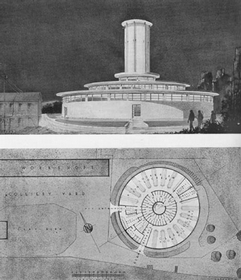The Story of Scottish Coal
Pithead baths at Arniston Colliery in Midlothian, near Edinburgh, designed by J A Webster in the mid-1930s. This was one of many baths for miners built with the assistance of the Miners' Welfare Fund.
© Crown copyright: RCAHMS, SC675019, c.1935
© Crown copyright: RCAHMS, SC675019, c.1935
In 1920, the formation of the Miners' Welfare Fund (MWF) resulted in a gradual improvement in the working conditions at many coal mines in Britain. They were able to do so through a levy placed by the Government on every ton of coal produced by each coal company. The resulting funds were set aside by the coal companies and used by the Miners' Welfare Fund to build educational and leisure facilities within the mining communities, and in particular, to construct baths and canteens at the mines themselves. This made a massive difference to many families, whose houses did not have bathrooms. In mines where baths were built, this allowed the miners to wash themselves thoroughly in hot showers before returning home. During the 1930s in particular, the art-deco architecture of some of the baths became famous, and in Scotland, architect J A Webster designed some especially fine buildings, such as that at Arniston Gore Colliery.


